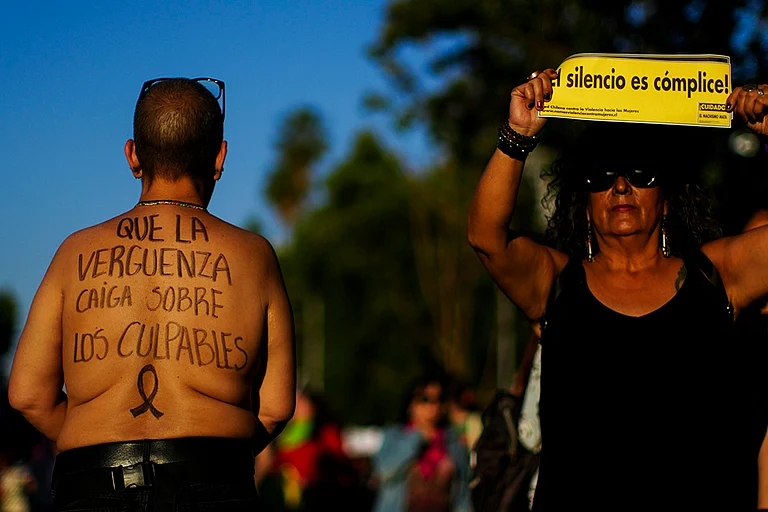International Day for the Elimination of Violence Against WomenFlags Rise in Digital Abuse
On International Day for the Elimination of Violence Against Women, AI-Driven Attacks Take Centre Stage
India Marks International Day for the Elimination of Violence Against Women With Push on Safer Digital Spaces
Is AI-Driven Violence Against Women Next 'Human Rights Emergency'?
From one woman murdered every ten minutes to 58 per cent of young women facing online harassment, rising AI-powered abuse signals a new women's safety emergency.
Every year on November 25, the International Day for the Elimination of Violence Against Women serves as a reminder of the global crisis of gender-based violence. Governments, international agencies, and civil society groups have intensified efforts through tougher legislation and coordinated advocacy, yet the scale of the problem remains vast.
In India too, gradual improvements in legal protections and support systems reflect a growing recognition of the need to safeguard women’s rights, women’s safety, strengthen gender equality, and confront the persistent social and digital threats faced by women and girls.
Established by the United Nations General Assembly in 2000, this day marks the start of the global 16 Days of Activism against Gender-Based Violence, which takes place from November 25 to December 10. For 2025, the international theme is “UNiTE to End Digital Violence against All Women and Girls”. From online harassment and cyberstalking to deepfakes, cyberstalking, doxxing, and coordinated misogynistic attacks, technology-facilitated gender-based violence has emerged as a disturbing new form of abuse.
What Data Tells Us
According to UN data, nearly one in three women worldwide has experienced almost one in three women have been subjected to physical and/or sexual intimate partner violence, non-partner sexual violence, or both, at least once in their life. Moreover, one woman or girl is murdered by a family member or intimate partner every ten minutes.
Additionally, in the digital dimension, 73 per cent of women journalists face online violence as per data collected by UNESCO (2023), “Your opinion doesn’t matter, anyway”, second edition. 58 per cent of young women and girls globally have experienced online harassment. It must be noted that 244 million more men than women use the Internet globally.
As a result, women have to curb their own internet freedom to some extent in many cases. In the case of women journalists, 30 per cent self-censor their work due to harassment. 26 per cent of women journalists report negative mental health impacts from online violence, and 20 per cent withdraw completely from online interactions.
Violence in digital spaces is entering an alarming phase with the advent of AI. Calling the trend a “global human rights emergency”, the UN notes: “It is a form of violence on the rise due to weak technological regulation, a lack of legal recognition of this type of aggression in some countries, the impunity of digital platforms, new and fast-evolving forms of abuse using AI, movements opposing gender equality, the anonymity of perpetrators, and the limited support for digital victims.
India’s efforts
Honouring this day, the Press Information Bureau released a statement highlighting the Indian government’s dedication to building a safer and more inclusive digital India for Women.
The Government of India has prioritised the elimination of violence against women through a multi-pronged approach, encompassing robust legal frameworks, institutional support, dedicated helplines, and flagship schemes, according to PIB.
These efforts, which emphasise both immediate and long-term empowerment, are in line with the International Day for the Elimination of Violence Against Women, which is observed on November 25. These programs are spearheaded by the Ministry of Women and Child Development (MWCD), which combines elements of empowerment (Samarthya) and safety (Sambal) under the Mission Shakti program.
The Government of India created the National Commission for Women (NCW) as a statutory body on January 31, 1992, with the mandate to review and oversee all legal and constitutional protections for women, suggest changes to current legislation when necessary, and look into complaints pertaining to the denial of women's rights.
State Commissions for Women (SCWs) have been established in the majority of states with similar duties. To provide a timely and efficient remedy, the NCW regularly processes complaints of violence and rights breaches against women.
It adds that through growing initiatives like Mission Shakti’s expanding network of One Stop Centres, Women Help Desks, and emergency helplines, along with reforms like the Bharatiya Nyaya Sanhita, 2023 and targeted tools such as SHe-Box, ITSSO, and the Digital Shakti Campaign, India is ensuring accessible reporting, survivor support, and faster justice. These integrated efforts reflect the nation’s commitment to building a safer, more inclusive environment where every woman and girl — both offline and online can live with dignity, freedom, and equal opportunity.

